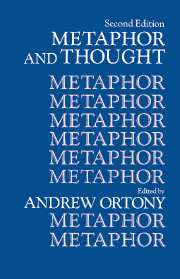Book contents
- Frontmatter
- Contents
- List of contributors
- Preface to the second edition
- Preface to the first edition
- 1 Metaphor, language, and thought
- METAPHOR AND MEANING
- METAPHOR AND REPRESENTATION
- METAPHOR AND UNDERSTANDING
- 14 Psychological processes in metaphor comprehension and memory
- 15 The interpretation of novel metaphors
- 16 The role of similarity in similes and metaphors
- 17 Images and models, similes and metaphors
- 18 How metaphors work
- 19 Metaphor and irony: Two levels of understanding
- METAPHOR AND SCIENCE
- METAPHOR AND EDUCATION
- References
- Author index
- Subject index
14 - Psychological processes in metaphor comprehension and memory
Published online by Cambridge University Press: 05 June 2012
- Frontmatter
- Contents
- List of contributors
- Preface to the second edition
- Preface to the first edition
- 1 Metaphor, language, and thought
- METAPHOR AND MEANING
- METAPHOR AND REPRESENTATION
- METAPHOR AND UNDERSTANDING
- 14 Psychological processes in metaphor comprehension and memory
- 15 The interpretation of novel metaphors
- 16 The role of similarity in similes and metaphors
- 17 Images and models, similes and metaphors
- 18 How metaphors work
- 19 Metaphor and irony: Two levels of understanding
- METAPHOR AND SCIENCE
- METAPHOR AND EDUCATION
- References
- Author index
- Subject index
Summary
For the student of language and thought, metaphor is a solar eclipse. It hides the object of study and at the same time reveals some of its most salient and interesting characteristics when viewed through the right telescope. The object is linguistic meaning. Metaphor obscures its literal and commonplace aspects while permitting a new and subtle understanding to emerge. Thus, metaphor highlights the capacity of language users to create and understand novel linguistic combinations that may be literal nonsense. An advertisement that urges you to “Put a tiger in your tank” is anomalous semantically but not in what it symbolizes for the driver who likes to take off with a roar. Most metaphors are not newly created by their users, but all were once novel and new ones arise constantly even in the most commonplace of conversations. Thus, semantic productivity must be regarded as a salient design feature of metaphorical language, just as syntactic productivity is of language in general, despite the repetitiousness of specific grammatical constructions in everyday speech. We know even less, however, about the psychology of semantic creativity than we do about syntactic creativity, and the former must be counted among the most challenging theoretical problems that confront those who are interested in a scientific understanding of language behavior.
The degree of semantic creativity in metaphorical language, and the problem it poses for language theory, have been emphasized by psychologists (e.g., Anderson & Ortony, 1975; Bransford & McCarrell, 1975; Honeck, Riechmann, & Hoffmann, 1975; Olson, 1970).
- Type
- Chapter
- Information
- Metaphor and Thought , pp. 307 - 328Publisher: Cambridge University PressPrint publication year: 1993
- 31
- Cited by



